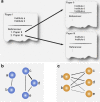Importance of scientific collaboration in contemporary drug discovery and development: a detailed network analysis
- PMID: 33050894
- PMCID: PMC7556984
- DOI: 10.1186/s12915-020-00868-3
Importance of scientific collaboration in contemporary drug discovery and development: a detailed network analysis
Abstract
Background: Growing evidence shows that scientific collaboration plays a crucial role in transformative innovation in the life sciences. For example, contemporary drug discovery and development reflects the work of teams of individuals from academic centers, the pharmaceutical industry, the regulatory science community, health care providers, and patients. However, public understanding of how collaborations between academia and industry catalyze novel target identification and first-in-class drug discovery is limited.
Results: We perform a comprehensive network analysis on a large scientific corpus of collaboration and citations (97,688 papers with 1,862,500 citations from 170 million scientific records) to quantify the success trajectory of innovative drug development. By focusing on four types of cardiovascular drugs, we demonstrate how knowledge flows between institutions to highlight the underlying contributions of many different institutions in the development of a new drug. We highlight how such network analysis could help to increase industrial and governmental support, and improve the efficiency or accelerate decision-making in drug discovery and development.
Conclusion: We demonstrate that network analysis of large public databases can identify and quantify investigator and institutional relationships in drug discovery and development. If broadly applied, this type of network analysis may help to enhance public understanding of and support for biomedical research, and could identify factors that facilitate decision-making in first-in-class drug discovery among academia, the pharmaceutical industry, and healthcare systems.
Keywords: Cardiovascular disease; Collaboration network; Drug discovery; Network analysis; PCSK9; Scientific collaboration; TNF inhibitors.
Conflict of interest statement
Joseph Loscalzo is the scientific co-founder of Scipher Medicine, Inc., a start-up company that uses network medicine to identify biomarkers for disease and specific pathway targets for drug development. The other authors declare no competing interests.
Figures




References
Publication types
MeSH terms
Substances
Grants and funding
LinkOut - more resources
Full Text Sources
Miscellaneous

